Are you ready for some football history? The NFL started in 1920 and commemorated its 100th season in 2019 with a season-long celebration of “NFL 100.”
The game has come a long way in 100 years. The most obvious change from 1920 to today is the size of players, but there also have been many changes in the schemes and roles of individual positions.
This evolution, position by position and era by era, has advanced the game. It’s sometimes hard to notice changes on a year-by-year basis, but when comparing 20-year spans, some patterns emerge.
Time will tell where the league goes 20 years from now, but this is how the NFL has evolved over its first 100 years.
Note: All heights and weights are taken from Pro Football Reference.
1920-1939: Quarterback

Dutch Clark in 1928. AP Photo
Average height: 5-foot-10
Average weight: 175 pounds
Top players: Arnie Herber, Dutch Clark, Ed Danowski, Bernie Masterson, Bob Monnett
Bottom line: Statistics for individual players were scarce during the NFL’s formative years, but we do know that the passing game was almost an afterthought during this period.
Nearly every “quarterback” was a running back first and foremost, and it was quite common for one player to lead his team in both passing and rushing yards.
1940-1959: Quarterback
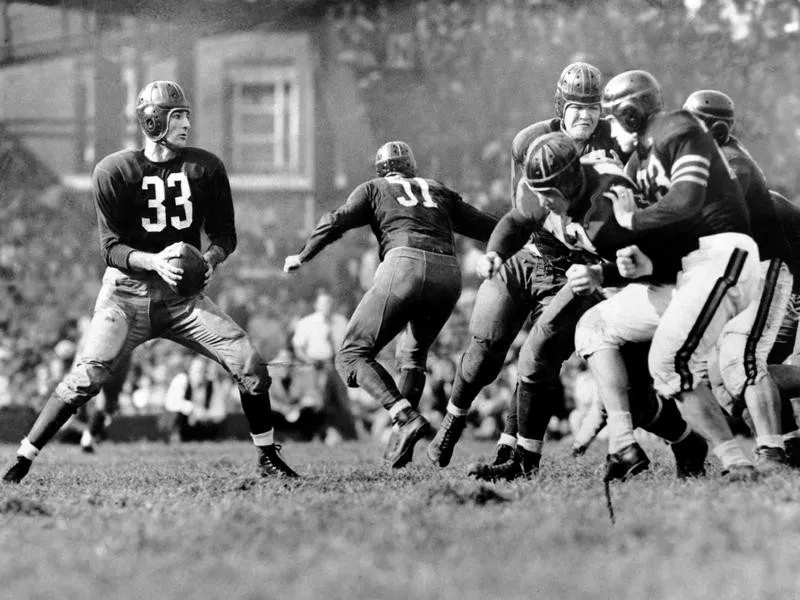
Washington Redskins quarterback Sammy Baugh drops back to pass against the Chicago Bears in Washington, D.C., in 1942. AP Photo
Average height: 6-foot-1
Average weight: 193 pounds
Top players: Otto Graham, Sammy Baugh, Sid Luckman, Bobby Layne, Norm Van Brocklin
Bottom line: During this era, quarterbacks began to focus solely on one offensive position, although many, like Sid Luckman, also played both defense and on special teams.
The premier passer was Sammy Baugh, who made the forward pass a weapon instead of just a last option.
In 1940, Baugh led the NFL with 12 touchdown passes, but by 1959, Johnny Unitas had nearly tripled that amount and led the league with 32 passing touchdowns.
1960-1979: Quarterback
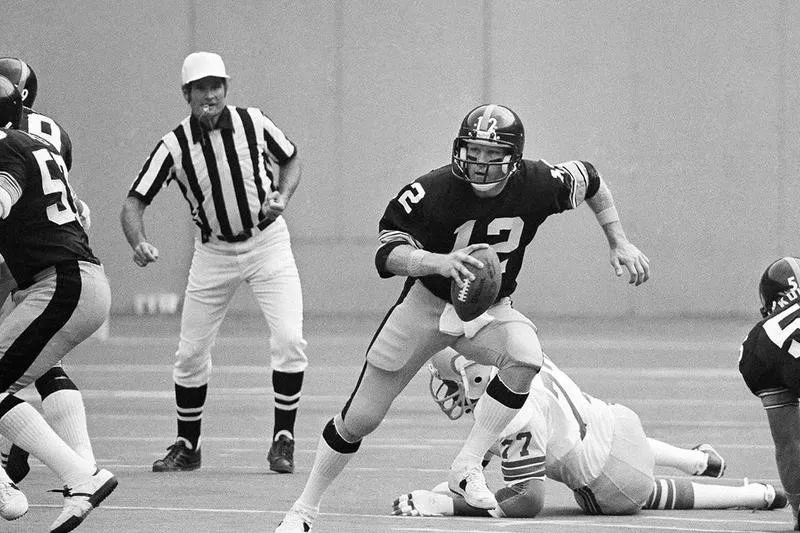
Terry Bradshaw, a veteran with the Pittsburgh Steelers, in 1979. AP Photo
Average height: 6 feet, 2 inches
Average weight: 200 pounds
Top players: Johnny Unitas, Bart Starr, Roger Staubach, Terry Bradshaw, Joe Namath
Bottom line: By the time the 1960s rolled around, two-way players were a thing of the past, and the top quarterbacks started crossing over into mainstream media.
Joe Namath hosted his own talk show while an active player. Terry Bradshaw acted in commercials and movies, and Roger Staubach was the star player of America’s team.
It was during these years when quarterbacks emerged to become the faces of their respective franchises.
1980-1999: Quarterback
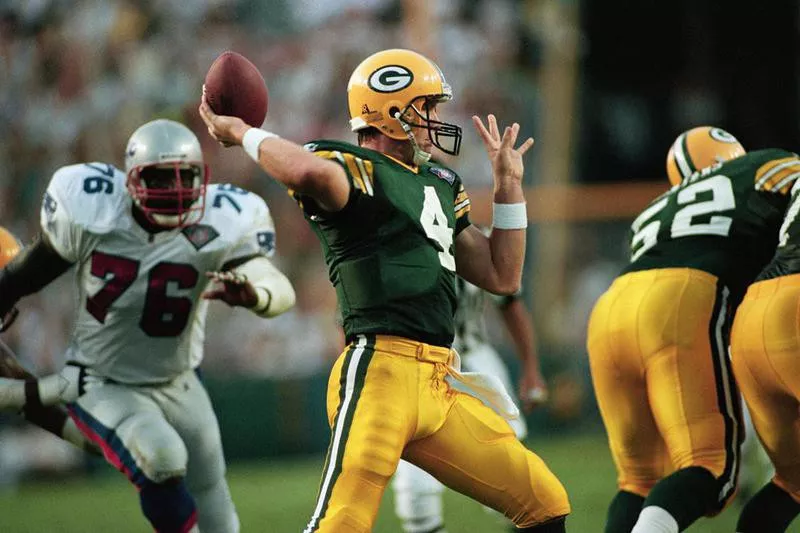
Green Bay Packers quarterback Brett Favre passes under pressure from the New England Patriots in 1994 at Lambeau Field. Roberto Boreo / AP Photo
Average height: 6 feet, 3 inches
Average weight: 210 pounds
Top players: Joe Montana, Dan Marino, John Elway, Brett Favre, Steve Young
Bottom line: Every team was searching for the prototypical quarterback, and that prototype usually had a specific size to it.
Of the 38 quarterbacks drafted in the first round between 1980 and 1999, all but two of them were at least 6 feet, 2 inches.
If a team was going to draft someone smaller — like Joe Montana, who was taken in 1979 — they were going to wait for the later rounds to do so.
2000-present: Quarterback

Drew Brees has rewritten the NFL record books with the Saints. Jason Behnken / AP Photo
Average height: 6 feet, 3 inches
Average weight: 223 pounds
Top players: Tom Brady, Peyton Manning, Aaron Rodgers, Drew Brees, Ben Roethlisberger
Bottom line: The passing game further evolved, with moving the ball through the air taking precedence over moving it on the ground.
While teams still looked for prototypical-sized quarterbacks at the start of this era, toward the end, opinions had changed, and teams simply wanted a great quarterback.
The productiveness of someone like 6-foot-tall Drew Brees played a big part in that philosophical shift and eased teams’ concerns, which enabled them to draft players like Baker Mayfield and Kyler Murray first overall.
1920-1939: Running Back
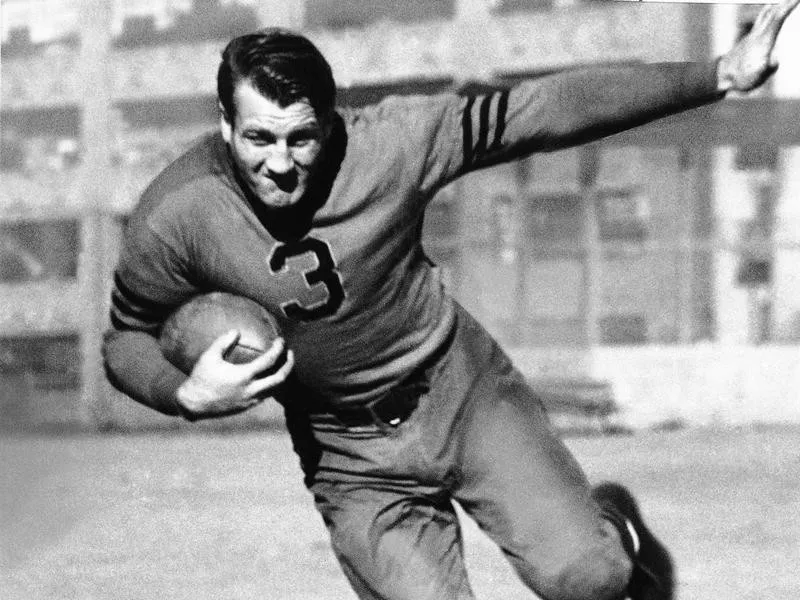
Bronko Nagurski with the Chicago Bears in the 1930s. (AP Photo) AP Photo
Average height: 5 feet, 10 inches
Average weight: 189 pounds
Top players: Bronko Nagurski, Ernie Nevers, Ken Strong, Red Grange, Tuffy Leemans
Bottom line: While most running backs in the 1920s and ’30s clocked in at under six feet and 200 pounds, Bronko Nagurski was an outlier at 6 feet, 2 inches and 230 pounds.
That height and weight made him bigger than the average lineman of his day, and he used the size to his advantage as teams in those days ran the ball upward of 40 times a game.
1940-1959: Running Back
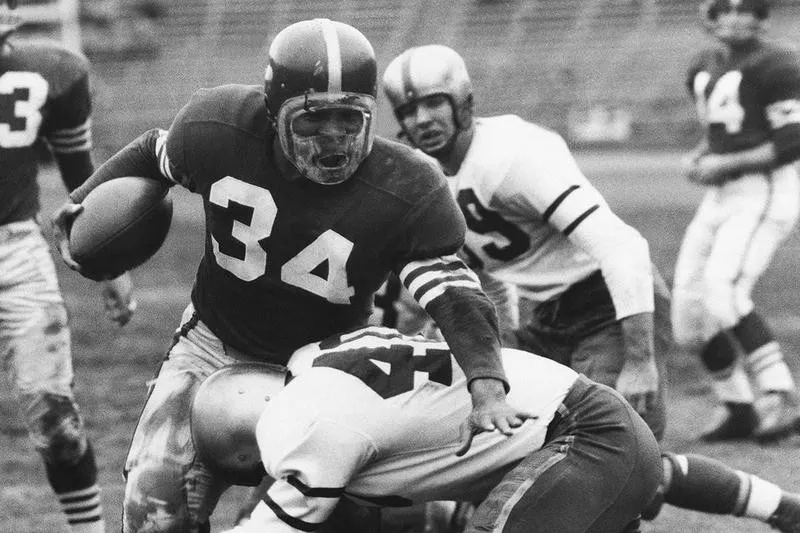
San Francisco 49ers fullback Joe “The Jet” Perry blasts his way through the Green Bay Packers’ defense for a touchdown in 1953 in San Francisco. AP Photo
Average height: 6 feet, 1 inch
Average weight: 196 pounds
Top players: Frank Gifford, Joe Perry, John Henry Johnson, Marion Motley, Steve Van Buren
Bottom line: This was the era of the T-formation, which featured one fullback and two halfbacks in the backfield, along with two tight ends making up the rest of the skill position players.
As the formation suggested, offenses were run-heavy, and it wasn’t uncommon to see multiple Pro Bowl running backs on one team.
An example of that is the “Million Dollar Backfield” of the 49ers, which had Hall of Fame running backs John Henry Johnson and Joe Perry from 1954 to 1956.
1960-1979: Running Back
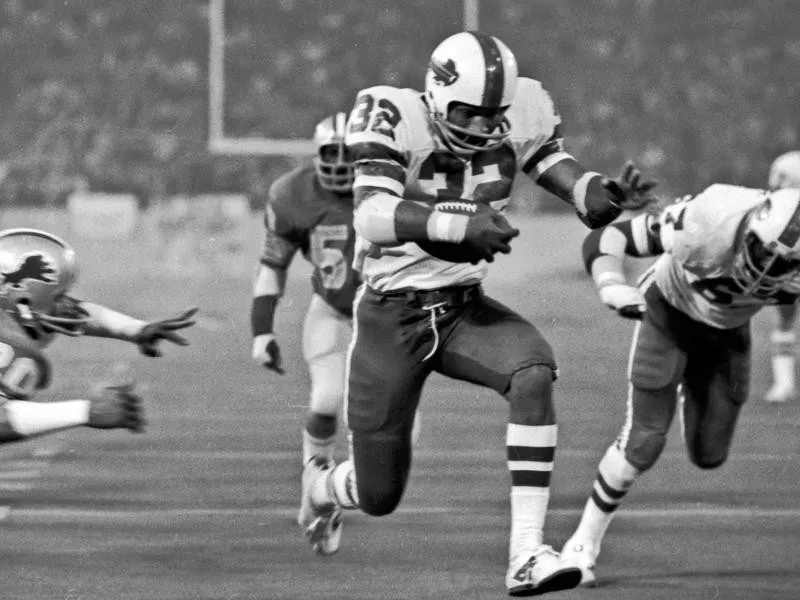
Buffalo Bills running bacck O.J. Simpson rushes through a large hole againt the Detroit Lions in 1976. AP Photo
Average height: 6 feet, 1 inch
Average weight: 215 pounds
Top players: Jim Brown, Gale Sayers, O.J. Simpson, Franco Harris, Larry Csonka
Bottom line: This was the era of the big, bruising running backs as evident by the players that were stars in this period.
There are seven Hall of Fame running backs who weighed at least 230 pounds, and five of them played in this time frame.
In 1973, O.J. Simpson, the former Heisman Trophy winner from Southern Cal, became the first player in NFL history to run for more than 2,000 yards in a season, finishing with 2,003 yards for the Bills.
1980-1999: Running Back
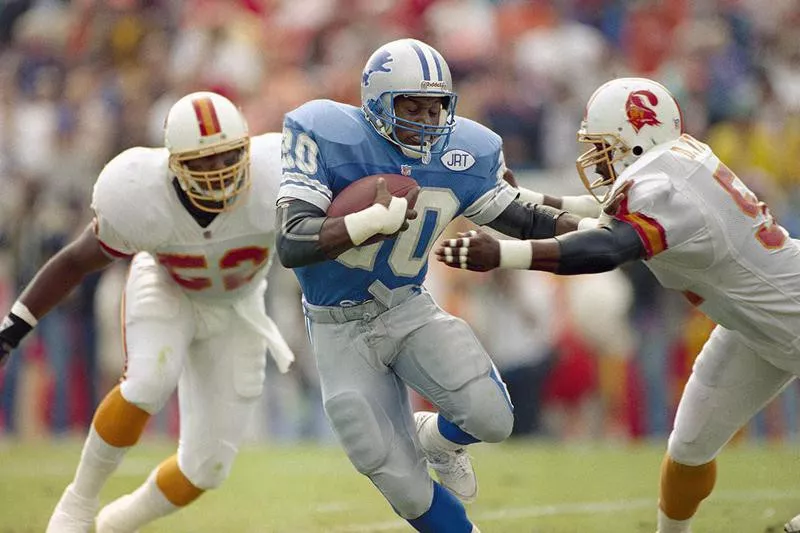
Detroit Lions running back Barry Sanders plows his way through the Tampa Bay Buccaneers in 1991. Chris O’Meara / AP Photo
Average height: 6 feet, 0 inches
Average weight: 211 pounds
Top players: Walter Payton, Barry Sanders, Emmitt Smith, Marcus Allen, Eric Dickerson
Bottom line: Toward the end of the century, teams began to move away from fullbacks carrying the ball, and they began to be used as blockers for the most part.
Halfbacks were the fulcrum of offenses, and most teams believed the road to a Super Bowl came on the ground.
Three-down backs were the norm. Look at the 1992 Detroit Lions, who gave Barry Sanders 312 carries and his backups 13 carries the entire season.
2000-present: Running Back
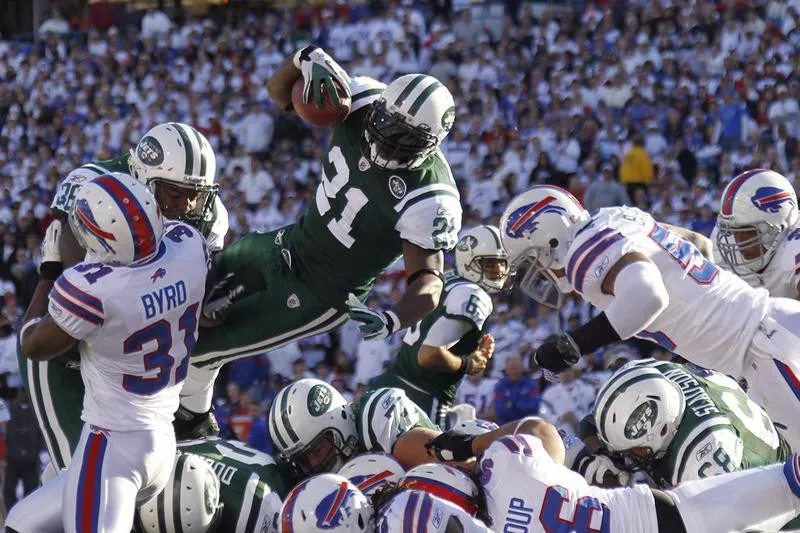
New York Jets running back LaDainian Tomlinson scores a touchdown against the Buffalo Bills in 2011. Derek Gee / AP Photo
Average height: 5 feet, 11 inches
Average weight: 218 pounds
Top players: LaDainian Tomlinson, Adrian Peterson, Marshall Faulk, LeSean McCoy, Marshawn Lynch
Bottom line: Today’s running backs are shorter, but heavier than at any point in the last 80 years of the NFL.
Backs have become more specialized than ever before as teams have moved away from the workhorse running back. You have your early-downs back, your third-down pass-catching back and your short-yardage goal-line back all within one backfield.
Many teams no longer even carry fullbacks on their roster and prefer having an extra tight end or receiver.
1920-1939: Wide Receiver/Tight End
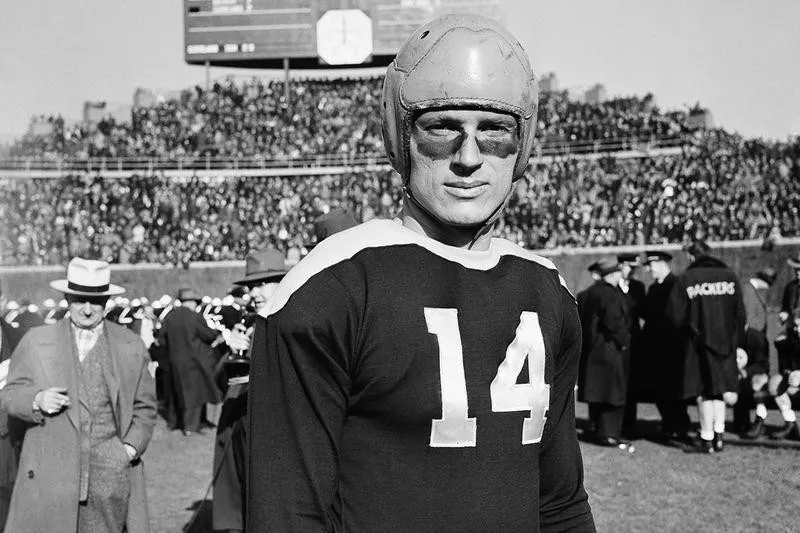
Green Bay Packers receiver Don Hutson in 1934. Robert Walsh / AP Photo
Average height: 6 feet, 0 inches
Average weight: 196 pounds
Top players: Don Hutson, Bill Hewitt, Wayne Millner, Red Badgro, Johnny Bloo
Bottom line: Wide receivers weren’t really thought of that much until the Babe Ruth of receivers came along in 1935.
Don Hutson joined the NFL that year, and just as Ruth would routinely outhomer other teams, Hutson would routinely catch more touchdowns than entire teams.
He and other receivers of this era did this from the “end” position, which looks like a modern-day tight end position with players lined up on the line of scrimmage outside of the tackles.
1940-1959: Wide Receiver/Tight End
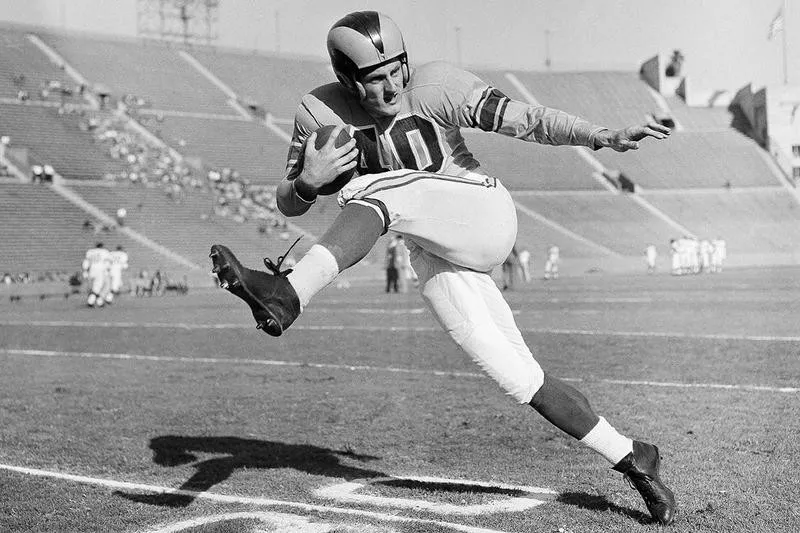
Los Angeles Rams split end Elroy “Crazy Legs” Hirsch in 1953. Harold Filan / AP Photo
Average height: 6 feet, 2 inches
Average weight: 204 pounds
Top players: Elroy Hirsch, Raymond Berry, Tom Fears, Dante Lavelli, Pete Pihos
Bottom line: The end position of the early days was split out wide to create the split end position. Then, one of the three running backs was flanked out wide to create the flanker position.
Both positions look similar to modern-day wide receivers, but you would rarely ever see more than two of them on the field at the same time.
1960-1979: Wide Receiver/Tight End
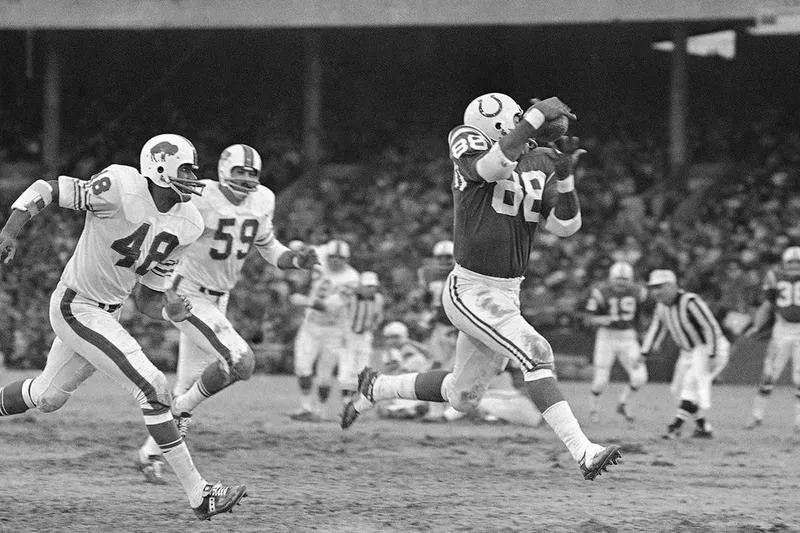
Baltimore Colts tight end John Mackey catches a pass for a touchdown against the Buffalo Bills in 1970. AP Photo
Average height: 6 feet, 3 inches
Average weight: 208 pounds
Top players: Fred Biletnikoff, Paul Warfield, Lance Alworth, Mike Ditka, John Mackey
Bottom line: Here is where teams started experimenting with three-receiver sets. This was also when the other end position transformed into the tight end position.
Great tight ends like Mike Ditka and John Mackey were actually receivers in college that became some of the NFL’s first tight ends. The demise of the two-way players factored into that as teams no longer had to have wide receivers who doubled as defensive backs and offensive linemen who doubled as defensive linemen or linebackers.
They could have someone in between the sizes of receivers and O-linemen, and the tight end was born.
1980-1999: Wide Receiver/Tight End
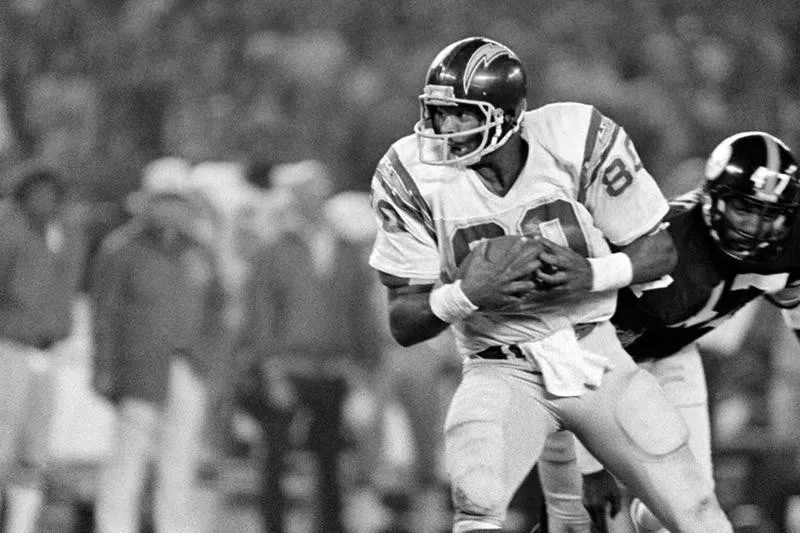
San Diego Chargers tight end Kellen Winslow makes a play against the Pittsburgh Steelers in 1980. Lenny Ignelzi / AP Photo
Average height: 6 feet, 2 inches
Average weight: 212 pounds
Top players: Jerry Rice, Cris Carter, Michael Irvin, Shannon Sharpe, Kellen Winslow
Bottom line: As three-receiver sets got popularized in the previous era, four and five-receiver sets became popular in this era. However, even as the passing game opened up, it was still common to see wide receivers line up in three-point stances in the early 1980s.
The tight end position evolved into a hybrid receiver position with tight ends now being split out or put in the slot.
Kellen Winslow is considered the godfather of the pass-catching tight end, and Bill Belichick labeled all future tight ends in his ilk as descendants of Winslow.
2000-present: Wide Receiver/Tight End
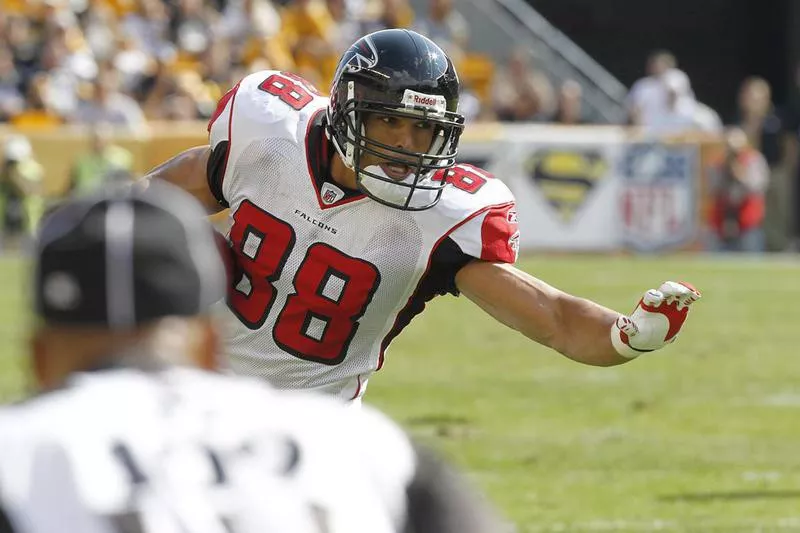
Atlanta Falcons tight end Tony Gonzalez seeks more yardage after making a catch against the Pittsburgh Steelers in 2010. Keith Srakocic / AP Photo
Average height: 6 feet, 2 inches
Average weight: 225 pounds
Top players: Randy Moss, Terrell Owens, Larry Fitzgerald, Tony Gonzalez, Antonio Gates, Rob Gronkowski
Bottom line: As the focus has shifted from the running game to the passing game, wide receivers are now considered more valuable than running backs. Defensive game plans are centered around stopping the star receiver whereas they were focused on the star running back for the first 80 years of the NFL.
The tight end further evolved from being just another weapon in an offense into being the main weapon for some teams. Players like Rob Gronkowski and Tony Gonzalez became the best players on their teams, which was something unheard of for a position that was blocking first/receiving second for so long.
1920-1939: Offensive Lineman
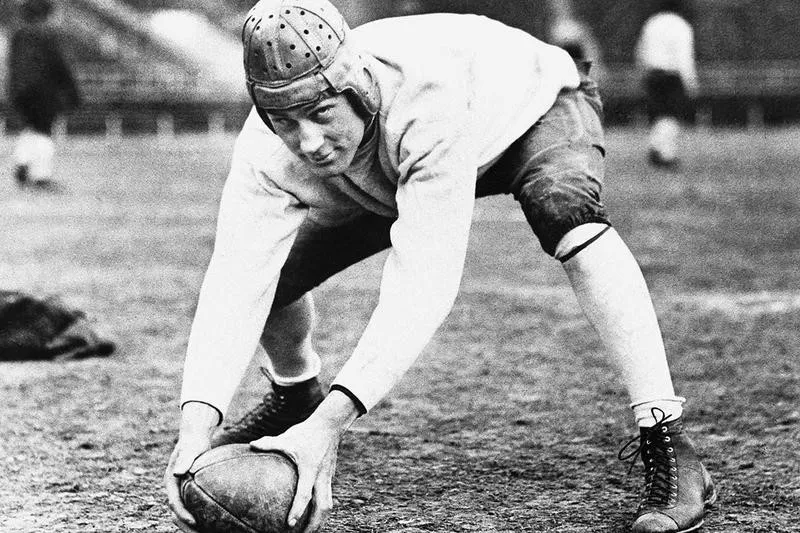
Mel Hein in 1930. AP Photo
Average height: 6 feet, 0 inches
Average weight: 215 pounds
Top players: Turk Edwards, Cal Hubbard, Mike Michalske, Mel Hein, George Trafton
Bottom line: To show you how much player sizes have increased, offensive linemen of the NFL’s first 20 years were the exact same sizes as running backs of today.
Virtually every player was a two-way player, so after offensive possessions, most linemen would just flip sides and stick their hands in the dirt as defensive linemen while the smaller ones would go to linebacker.
1940-1959: Offensive Lineman
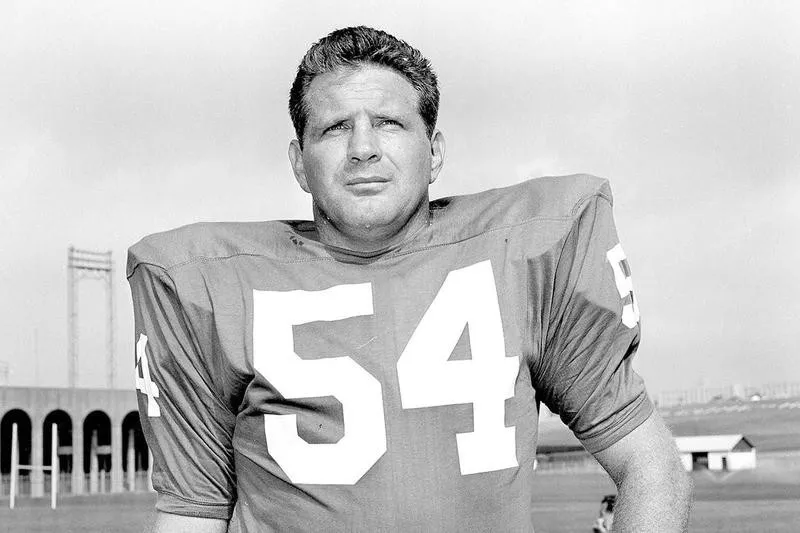
Philadelphia Eagles center Jim Ringo in 1964. AP Photo
Average height: 6 feet, 1 inch
Average weight: 228 pounds
Top players: Lou Creekmur, Rosey Brown, Jim Ringo, Frank Gatski, Bob St. Clair
Bottom line: Now is when there started to be more specialization amongst linemen in regards to positions along the line.
No longer did teams just plug in their five biggest players to random line positions. The more agile ones would go to tackle, the stronger ones would go to guard, and the smaller “big”saguys would go to center.
1960-1979: Offensive Lineman
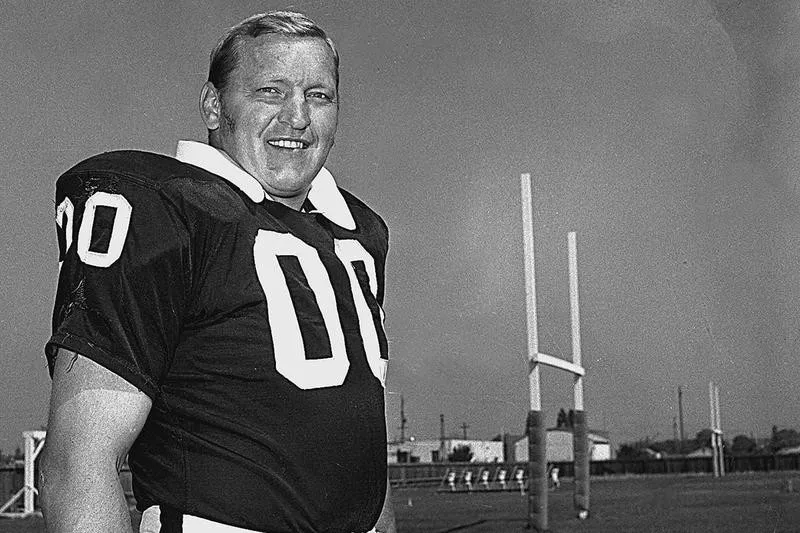
Oakland Raiders center Jim Otto in 1970. AP Photo
Average height: 6 feet, 3 inches
Average weight: 253 pounds
Top players: Jim Otto, Mick Tingelhoff, John Hannah, Gene Upshaw, Dan Dierdorf
Bottom line: With the demise of two-way players, linemen could focus on just one position, although those positions became more intricate.
An example is the Lombardi Sweep installed by the legendary Green Bay Packers head coach. Vince Lombardi had his two guards pulling on the famed play to clear running lanes for the likes of running back Paul Hornung.
1980-1999: Offensive Lineman
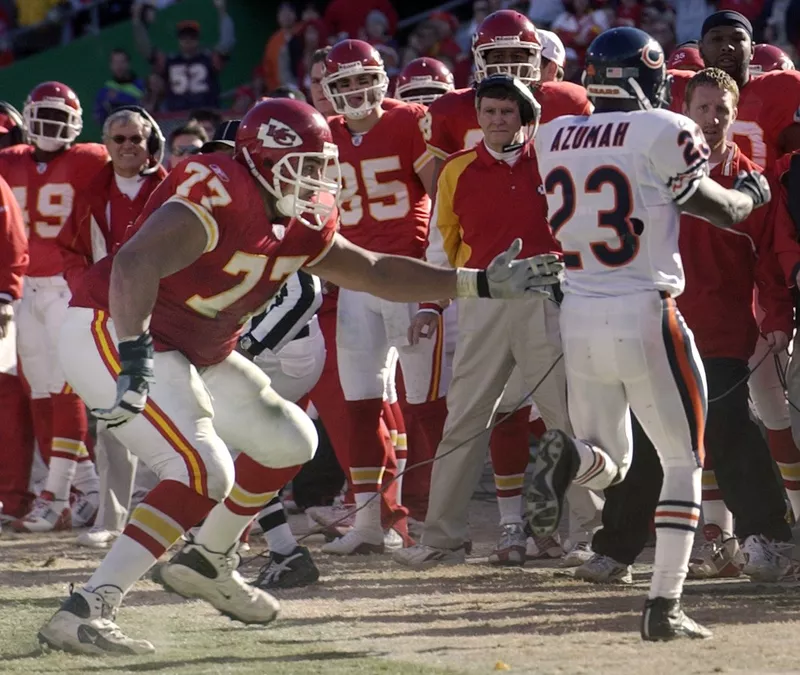
Kansas City Chiefs offensive lineman Willie Roaf, left, was one of the best O-lineman in NFL history. Reed Hoffmann / AP Photo
Average height: 6 feet, 4 inches
Average weight: 286 pounds
Top players: Larry Allen, Willie Roaf, Bruce Matthews, Dermontti Dawson, Anthony Munoz
Bottom line: No position made a bigger jump in player size than offensive linemen from the 1960s-1970s to the 1980s-1990s.
Linemen gained an average of 33 pounds despite growing one inch.
An increased focus on strength and conditioning played a big part in the bigger sizes.
2000-present: Offensive Lineman
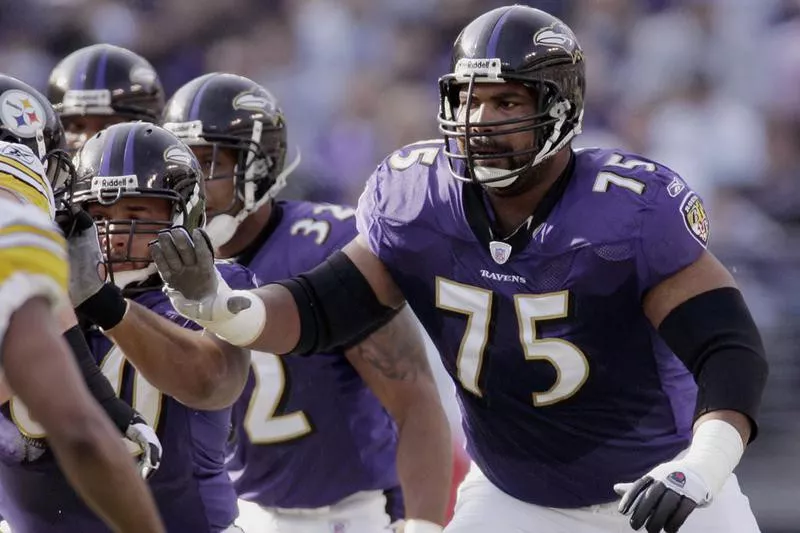
Baltimore Ravens offensive lineman Jonathan Ogden blocks against the Pittsburgh Steelers in 2006. Chris Gardner / AP Photo
Average height: 6 feet, 5 inches
Average weight: 315 pounds
Top players: Walter Jones, Jonathan Ogden, Joe Thomas, Jeff Saturday, Alan Faneca
Bottom line: With the passing game becoming more emphasized, franchises also put more of an emphasis on those who can protect the quarterback, namely offensive tackles.
Only three offensive linemen have been drafted first overall since the merger, and they all spent the bulk of their careers in this millennium.
A great offensive tackle has become the second-most coveted player for a team after a great quarterback.
1920-1939: Defensive Lineman
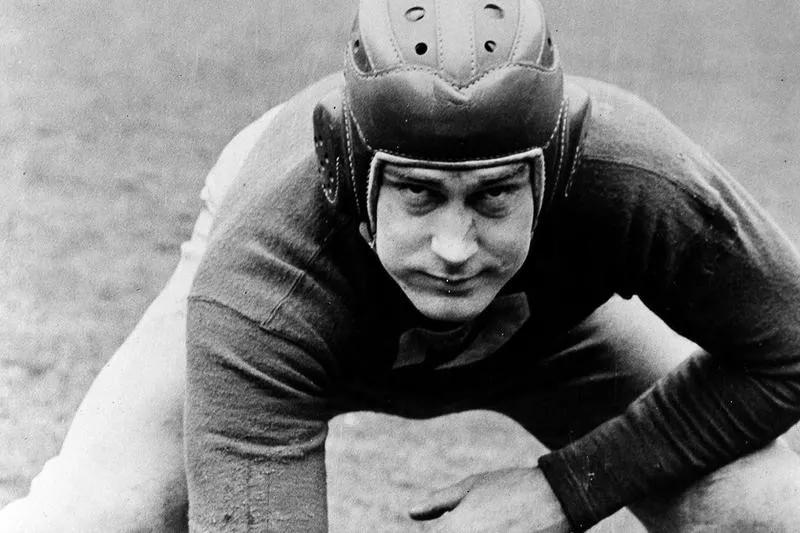
New York Giants player Mel Hein in 1939. AP Photo
Average height: 6 feet, 1 inch
Average weight: 210 pounds
Top players: Cal Hubbard, Steve Owen, Mel Hein, Turk Edwards, Ed Healey
Bottom line: During the NFL’s formative years, defensive linemen were slightly taller and slightly lighter than their offensive brethren. But they were mostly the same players in the two-way system of that era.
The most used defense was the 6-2 with six defensive linemen. As the pass game opened up in 1933, the 5-3 evolved as the pass defense to complement the 6-2.
1940-1959: Defensive Lineman
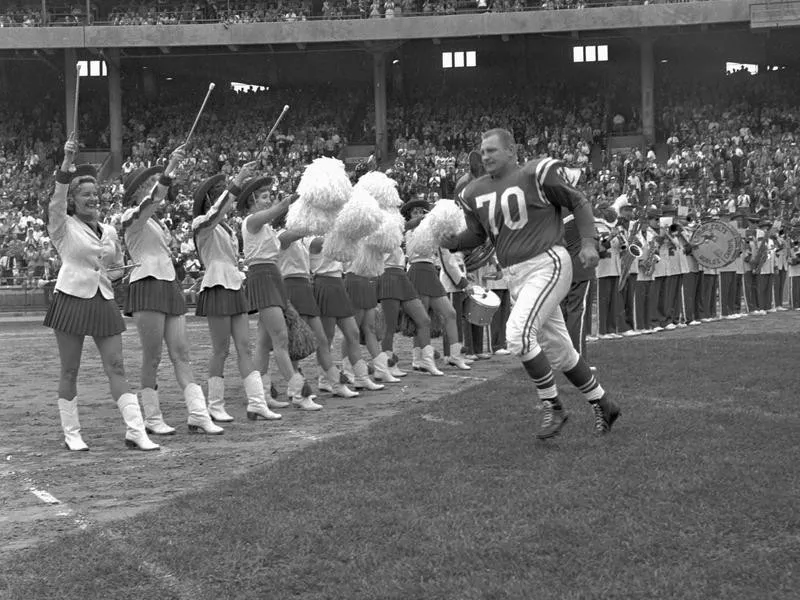
Baltimore Colts defensive tackle Art Donovan races onto the field before a game. AP Photo
Average height: 6 feet, 3 inches
Average weight: 236 pounds
Top players: Gino Marchetti, Art Donovan, Andy Robustelli, Arnie Weinmeister, Leo Nomellini
Bottom line: As the passing game further evolved, the 5-3 defense gave way to the standard 4-3 defense. Teams replaced a defensive lineman with a defensive back, which obviously added more team speed to the overall unit.
With two-way players still prevalent but not necessarily mandatory, many defensive linemen such as the Colts’ Gino Marchetti dabbled on the offensive line for a year just to see what worked and what didn’t work when going up against pass rushers.
1960-1979: Defensive Lineman
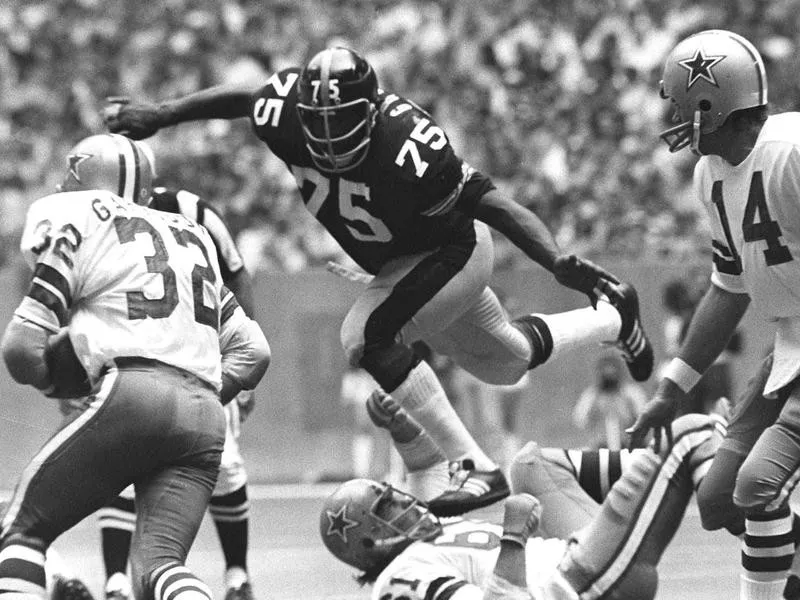
Pittsburgh Steelers left tackle Joe Greene takes a short cut against the Dallas Cowboys in 1972. Ferd Kaufman / AP Photo
Average height: 6 feet, 2 inches
Average weight: 255 pounds
Top players: Joe Greene, Deacon Jones, Carl Eller, Jack Youngblood, Bob Lilly
Bottom line: Toward the end of the 1970s, another defensive revolution hit the NFL. That was the 3-4 defense.
The linemen in those formations were a little bigger than those in a 4-3 formation. With one fewer lineman, there needed to be more girth for those with their hands in the dirt.
1980-1999: Defensive Lineman
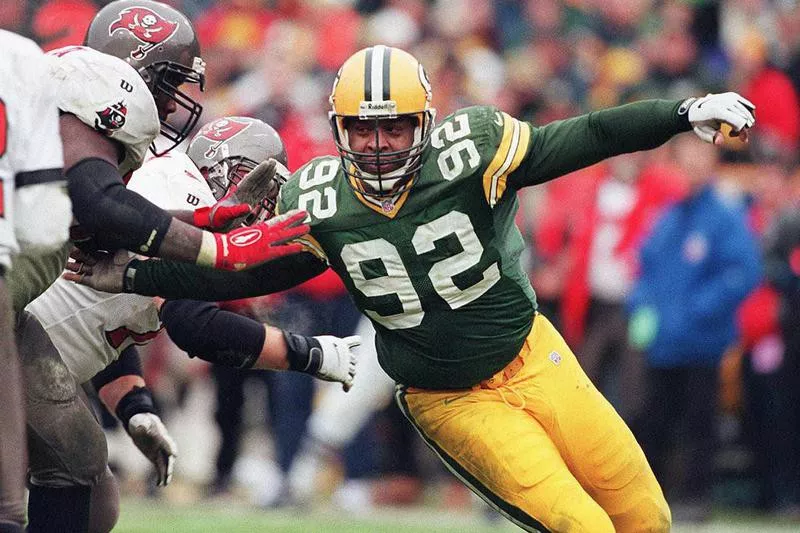
There’s a reason Reggie White was known as “The Minister of Defense.” Charles Krupa / AP Photo
Average height: 6 feet, 2 inches
Average weight: 271 pounds
Top players: Reggie White, Bruce Smith, John Randle, Charles Haley, Richard Dent
Bottom line: Sacks (or dumps as they once were called) had been a term in the NFL since the 1960s, but they didn’t become an official stat until 1982.
Finally defensive linemen had a measurement that was (almost) all their own, and taking down the quarterback became even more of a goal of linemen due to the accolades that followed with accumulating sacks.
2000-present: Defensive Lineman
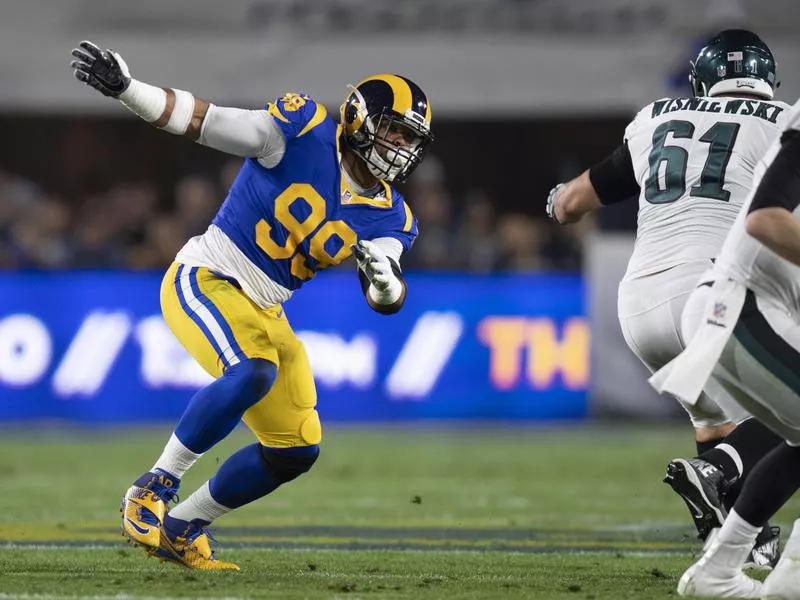
Los Angeles Rams defensive end Aaron Donald in a game against the Philadelphia Eagles in 2018. Kyusung Gong / AP Photo
Average height: 6 feet, 3 inches
Average weight: 295 pounds
Top players: Jason Taylor, J.J. Watt, Michael Strahan, Warren Sapp, Aaron Donald
Bottom line: The versatility of defensive linemen has gone to the next level in this current era.
You’ll see great players line up in nearly every position along the line. Not only that, but you’ll even see linemen dropping into coverage from time to time and acting as linebackers or defenders in space.
Taking things a step further, we’ve even seen great defensive linemen function as fullbacks or tight ends on offense. Warren Sapp, J.J. Watt, Jared Allen and others have caught passing touchdowns.
1920-1939: Linebacker
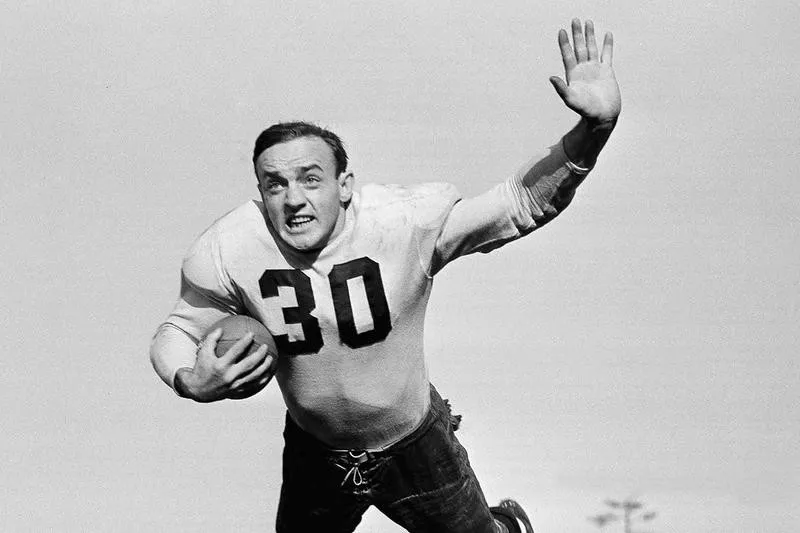
Clark Hinkle played on offense and defense for the Green Bay Packers. AP Photo
Average height: 6 feet, 0 inches
Average weight: 205 pounds
Top players: Mike Michalske, Danny Fortmann, Alex Wojciechowicz, Clark Hinkle, Bronko Nagurski
Bottom line: Many linebackers of the NFL’s formative years were also offensive linemen when on the other side of the ball.
The league wasn’t nearly as sophisticated back then as it is now, so there was no such thing as a blitzing linebacker, in part, because pass plays were so infrequent.
1940-1959: Linebacker

Philadelphia Eagles football player Chuck Bednarik is shown on July 29, 1959. AP Photo
Average height: 6 feet, 1 inch
Average weight: 218 pounds
Top players: Chuck Bednarik, Joe Schmidt, Bill George, Sam Huff, Tank Younger
Bottom line: As the passing game started to open up, linebackers were asked to do more on the field than just stop the run. They were often assigned to pass coverage also.
The two-way system started to fade out with Chuck Bednarik being the last of the two-way players. He was justly nicknamed “The 60-Minute Man” and was both the starting center and starting outside linebacker for the Eagles.
1960-1979: Linebacker
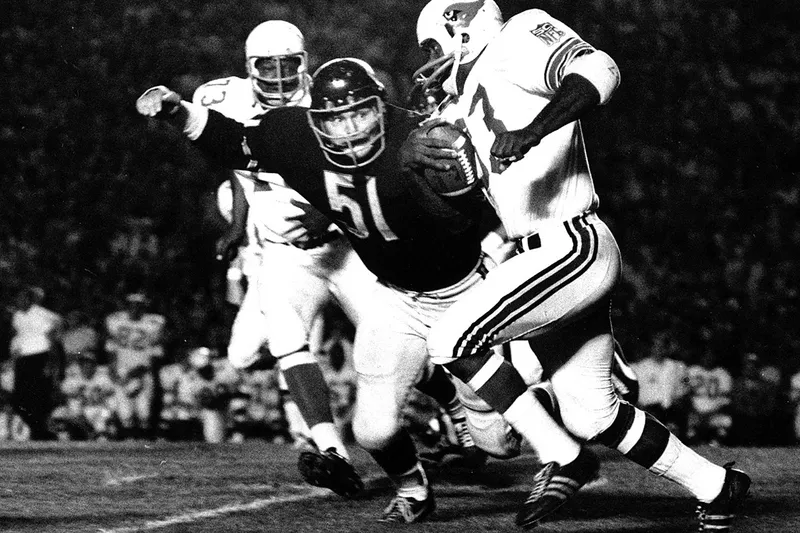
Chicago Bears linebacker Dick Butkus zeroes in on a St. Louis Cardinals player in 1969. AP Photo
Average height: 6 feet, 2 inches
Average weight: 225 pounds
Top players: Dick Butkus, Jack Ham, Jack Lambert, Ted Hendricks, Bobby Bell
Bottom line: This era produced some of the most iconic linebackers in NFL history and also some of the scariest looking.
Both Jack Lambert and Ray Nitschke were missing four of their front teeth, but neither of them may have been as intimidating as a fully toothed Dick Butkus, who had the nicknames of “The Animal,” “The Enforcer,” “The Maestro of Mayhem” and “The Robot of Destruction.”
1980-1999: Linebacker
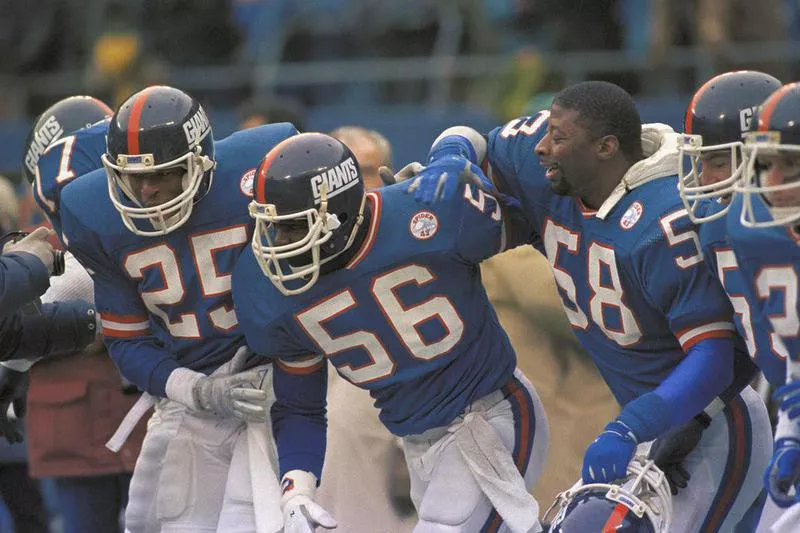
New York Giants linebacker Lawrence Taylor was a Hall of Fame disrupter on defense. Ray Stubblebine / AP Photo
Average height: 6 feet, 2 inches
Average weight: 232 pounds
Top players: Lawrence Taylor, Junior Seau, Mike Singletary, Derrick Thomas, Kevin Greene
Bottom line: Two things gained prominence at the beginning of the 1980s that changed the game of football forever.
One of those was the 3-4 defense, which got an extra linebacker on the field and gave rise to the zone blitz. The other was the rush linebacker, whose job was to attack the quarterback as opposed to the traditional role of a linebacker which was more of reading and reacting.
Lawrence Taylor epitomized this new attack mode.
2000-present: Linebacker
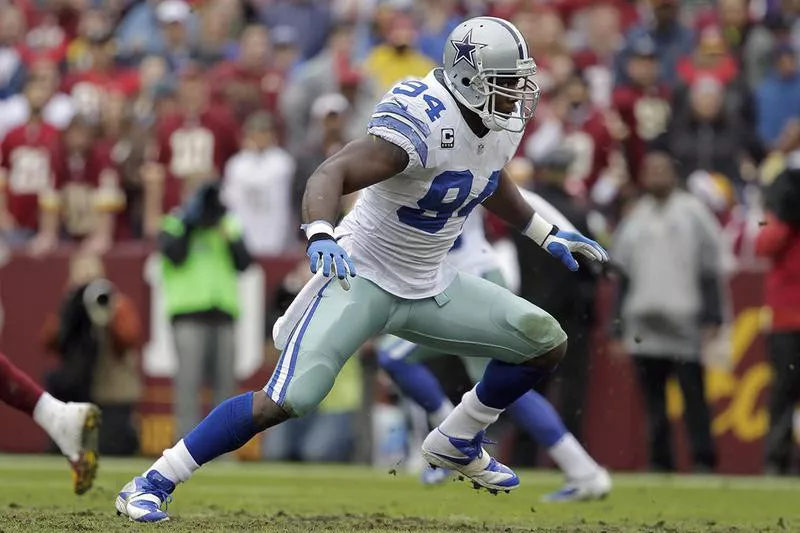
Dallas Cowboys linebacker DeMarcus Ware in 2013. Mark Tenally / AP Photo
Average height: 6 feet, 2 inches
Average weight: 245 pounds
Top players: Ray Lewis, DeMarcus Ware, Derrick Brooks, Von Miller, Luke Kuechly
Bottom line: In previous eras, the number of linebackers on the field has increased from two to three to four. This new era saw a decrease in favor of an extra defensive back.
When teams want more speed on the field, they’ll normally keep the same number of defensive linemen but sub out a linebacker for a DB.
1920-1939: Defensive Back
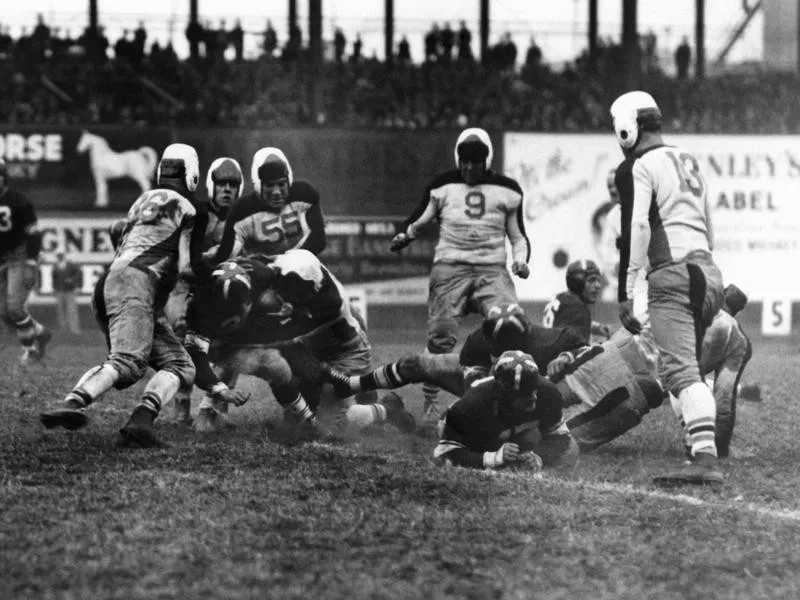
The New York Giants stop the Chicago Cardinals in 1935. AP Photo
Average height: 5 feet, 11 inches
Average weight: 185 pounds
Top players: Don Hutson, Ken Strong, Red Grange, Dutch Clark, Cliff Battles
Bottom line: Teams usually only had three defensive backs on the field, if that many, in these days with two cornerbacks and one safety.
Their responsibilities weren’t so much to defend the pass but rather to contain outside runs for the cornerbacks and to be the last line of defense for the safety.
1940-1959: Defensive Back
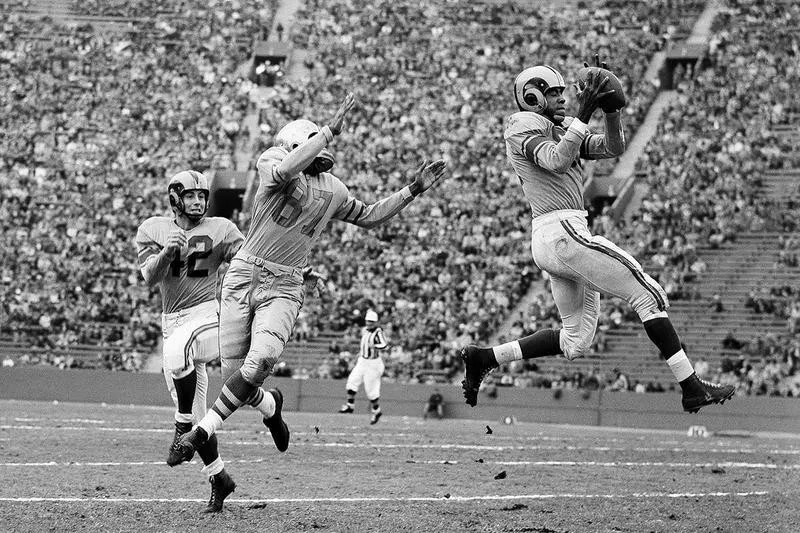
Los Angeles Rams defensive back Dick “Night Train” Lane leaps to intercept a Green Bay Packers pass in 1952. Harold P. Matosian / AP Photo
Average height: 6 feet, 0 inches
Average weight: 189 pounds
Top players: Dick “Night Train” Lane, Jack Butler, Yale Lary, Emlen Tunnell, Jack Christiansen
Bottom line: When the passing game opened up, defensive backs were the primary beneficiaries on defense as quarterbacks were much more liberal with the football than they are now.
Three of the top four single-season marks for defensive interceptions were set in this era, including Night Train Lane’s record 14 in 1952.
1960-1979: Defensive Back
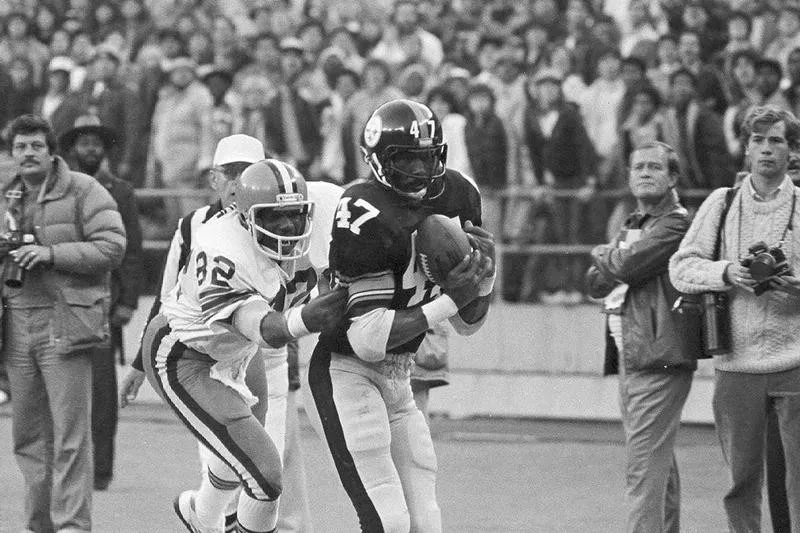
Pittsburgh Steelers defensive back Mel Blount was a menace for opposing offenses. Greenawalt / AP Photo
Average height: 6 feet, 0 inches
Average weight: 192 pounds
Top players: Paul Krause, Mel Blount, Ken Houston, Willie Brown, Lem Barney
Bottom line: If you love physicality out of your defenses, then this era was the perfect one for you. Cornerbacks were allowed to manhandle receivers up and down the field.
Mel Blount was the poster child for this type of play, using bump-and-run coverage from the hike to the whistle.
As a result, the illegal contact rule was enacted in 1978, and it’s also known as the Mel Blount Rule.
1980-1999: Defensive Back
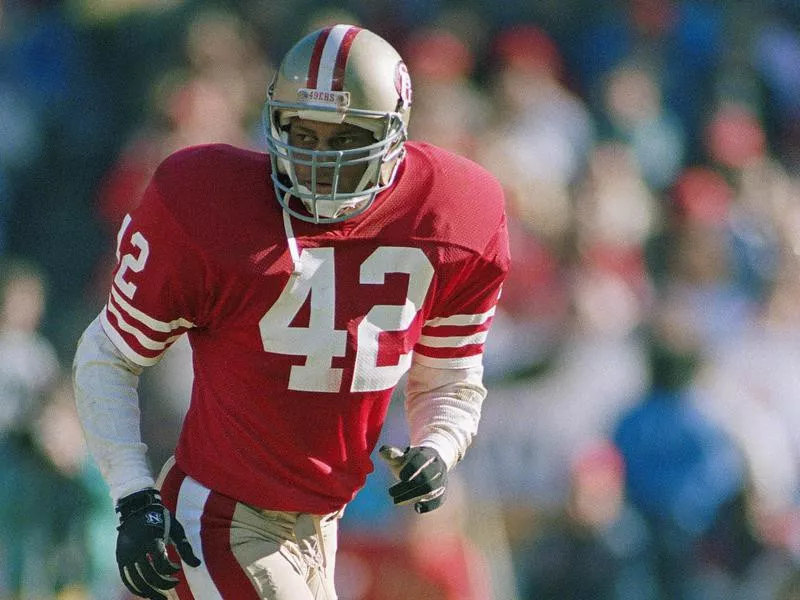
San Francisco 49ers free safety Ronnie Lott in 1989. John Gaps III / AP Photo
Average height: 6 feet, 0 inches
Average weight: 193 pounds
Top players: Ronnie Lott, Deion Sanders, Rod Woodson, Darrell Green, Aeneas Williams
Bottom line: Perhaps the most popular zone defense was created during this time frame as the Cover 2 or Tampa 2 swept over the NFL.
It required jack-of-all-trades cornerbacks who not only needed to be able to cover the players in their zones, but they also had to be able to tackle well.
2000-present: Defensive Back
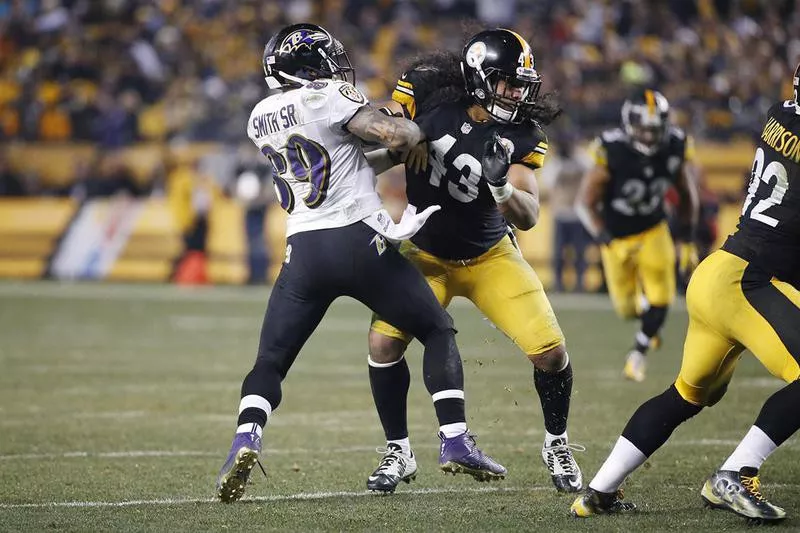
Pittsburgh Steelers strong safety Troy Polamalu in 2015. Gene J. Puskar / AP Photo
Average height: 6 feet, 0 inches
Average weight: 200 pounds
Top players: Ed Reed, Charles Woodson, Champ Bailey, Troy Polamalu, Darrelle Revis
Bottom line: Defensive backs have never been as important as they are now because the nickel defense has become the base defense for most teams.
That means five defensive backs are on the field to counter three-receiver sets, which have become the base offenses.
Interception totals for defensive backs are down since quarterbacks are more cautious, but the value of a great defensive back has never been higher.
1920-1939: Kicker/Punter
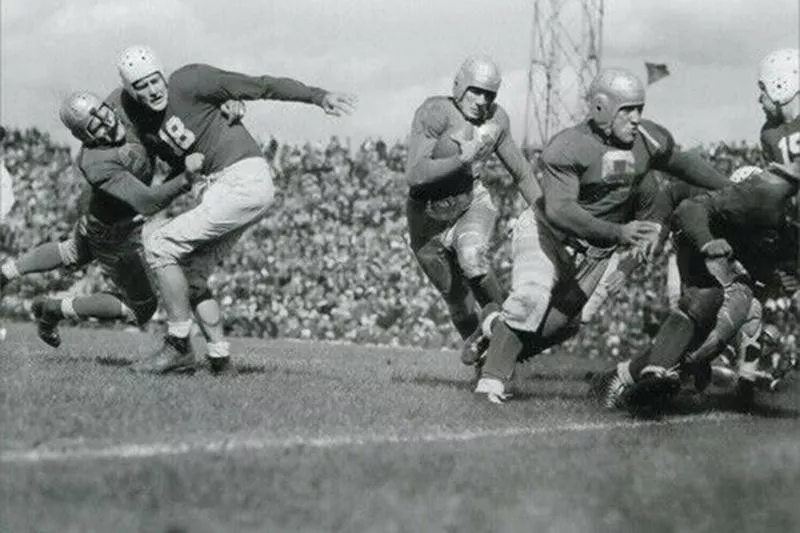
Johnny Pingel did more than just kick the football. eBay
Average height: 5 feet, 11 inches
Average weight: 198 pounds
Top players: Len Barnum, Bo Russell, Johnny Pingel, Gene Alford, Roy Andrews
Bottom line: The idea of a player only being a kicker or punter back in the day was laughable. These players were just position players who doubled up.
Teams would hold kicking/punting tryouts for their position players during training camp, and whoever was the best got the job.
1940-1959: Kicker/Punter
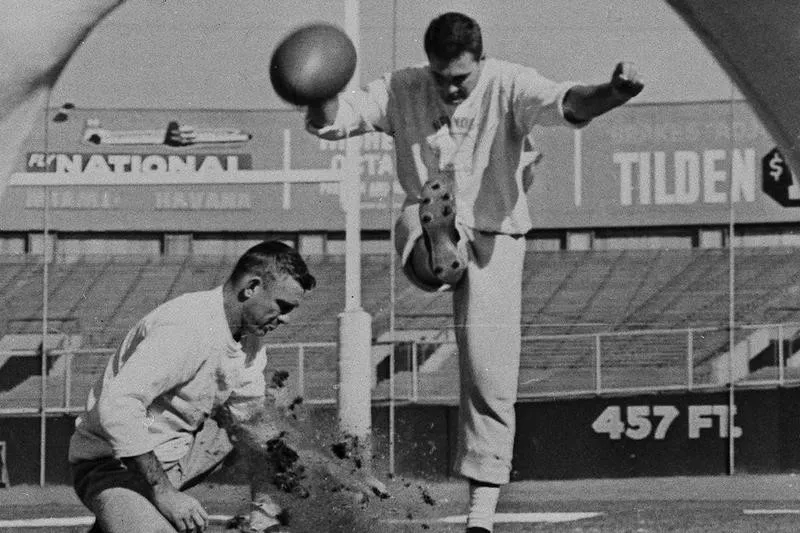
New York Giants kicker Pat Summerall in 1958. John Lindsay / AP Photo
Average height: 6 feet, 0 inches
Average weight: 200 pounds
Top players: Ben Agajanian, Pat Summerall, Sam Baker, Horace Gillom, Jug Girard
Bottom line: The first kicking specialists emerged during this era, although the majority of kickers and punters still doubled at other positions. And it showed.
In 1955, kickers across the league hit only 46 percent of their field-goal attempts.
Those players clearly spent more time on their other positions than on their kicking position.
1960-1979: Kicker/Punter
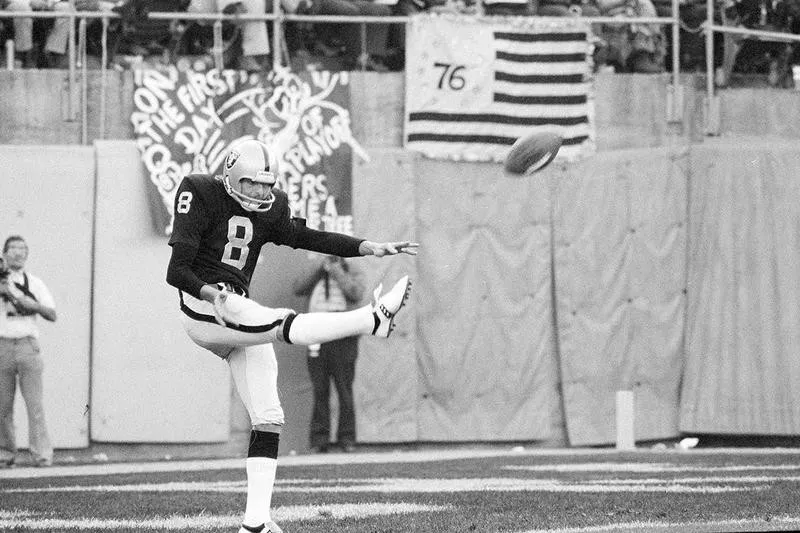
Oakland Raiders punter Ray Guy shown in action in 1976. AP Photo
Average height: 6 feet, 1 inch
Average weight: 208 pounds
Top players: Ray Guy, Jan Stenerud, George Blanda, Jim Turner, Jim Bakken
Bottom line: Punting specialists emerged during this era. Teams realized that the position could reach its full potential if a player fully devoted to the position.
The placekicker position also evolved as soccer-style kicking took over, with kickers standing behind the ball at an angle as opposed to straight on, which is how they previously did it.
1980-1999: Kicker/Punter
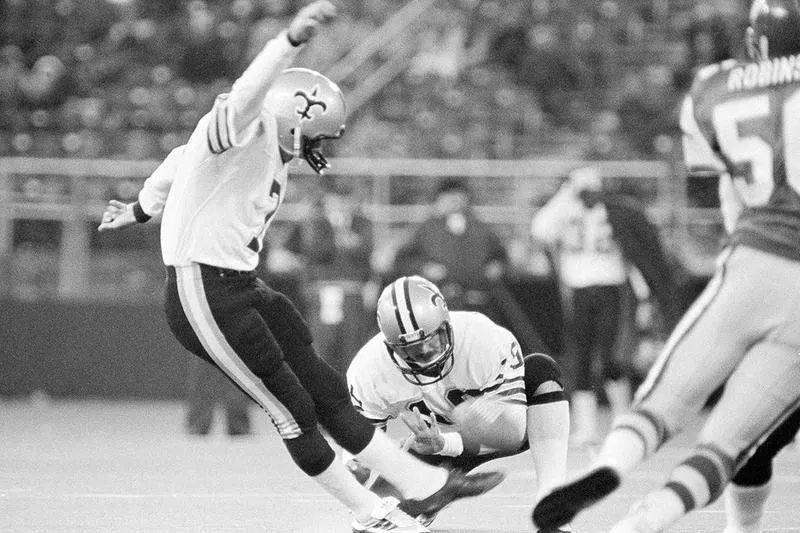
New Orleans Saints kicker Morten Andersen in 1983. Peter Morgan / AP Photo
Average height: 6 feet, 0 inches
Average weight: 200 pounds
Top players: Morten Andersen, Gary Anderson, Reggie Roby, Rohn Stark, Rich Camarillo
Bottom line: The last of the kickers and punters who doubled at other positions existed in this era. Danny White and Tom Tupa doubled as quarterbacks and punters.
The use of Australian rules football punters also came into prominence, and they introduced the drop punt in which the ball is dropped vertically and then punted.
2000-present: Kicker/Punter
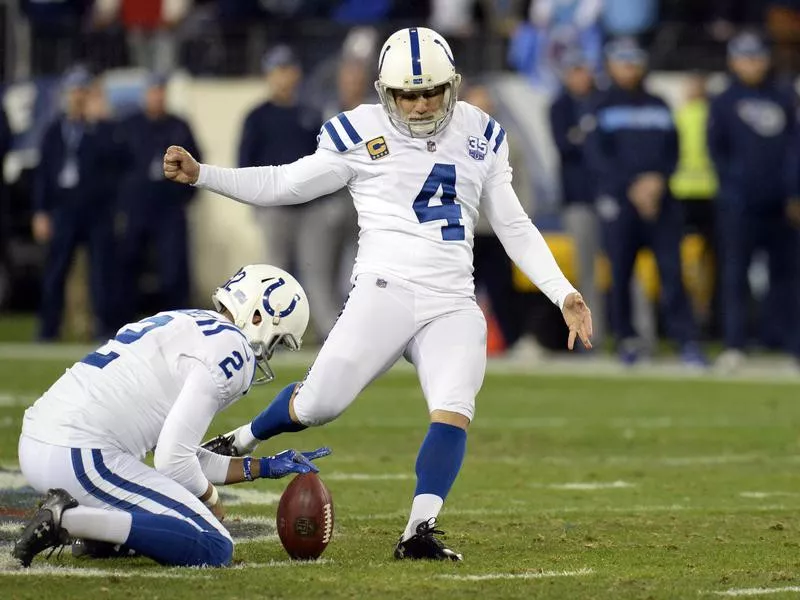
Indianapolis Colts kicker Adam Vinatieri kicks a 53-yard field goal against the Tennessee Titans in 2018. Mark Zaleski / AP Photo
Average height: 6 feet, 1 inch
Average weight: 205 pounds
Top players: Adam Vinatieri, Sebastian Janikowski, Justin Tucker, Shane Lechler, Johnny Hekker
Bottom line: Due to the nearly automatic accuracy of today’s kickers on extra-point attempts, the league was forced to move the XPA back to make things harder on kickers.
Additionally, teams are putting more on the feet of kickers as they have made the kickoff specialist position obsolete.
No longer will teams devote roster spots to both placekickers and kickoff specialists as one person is now expected to handle both jobs.